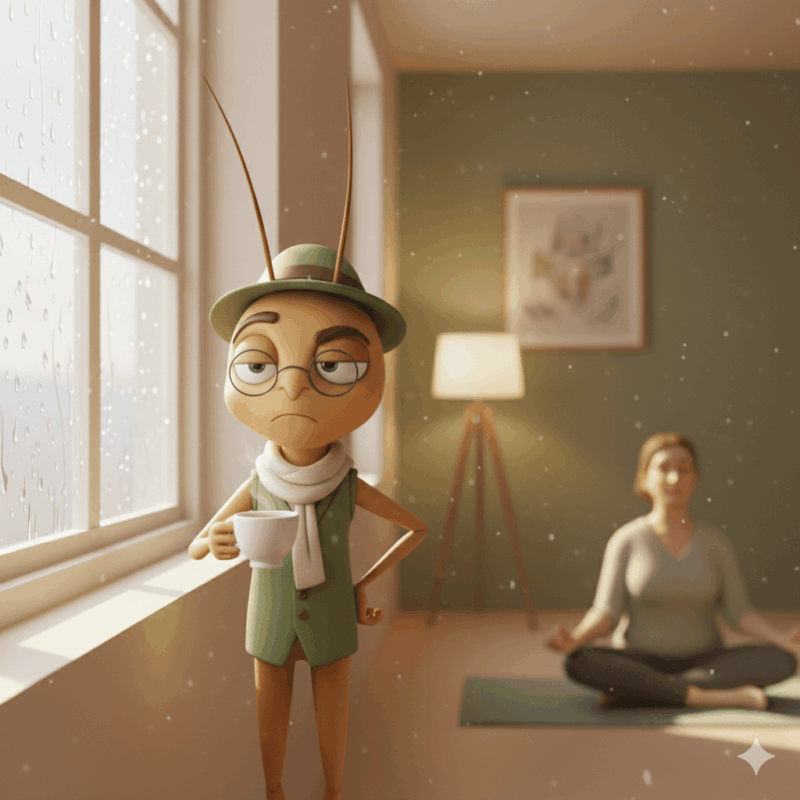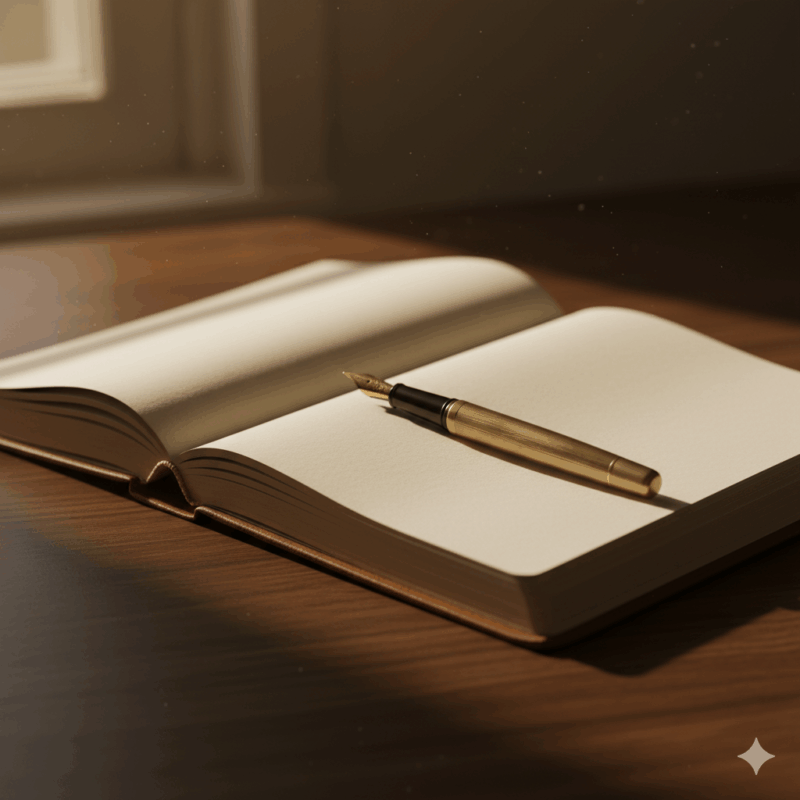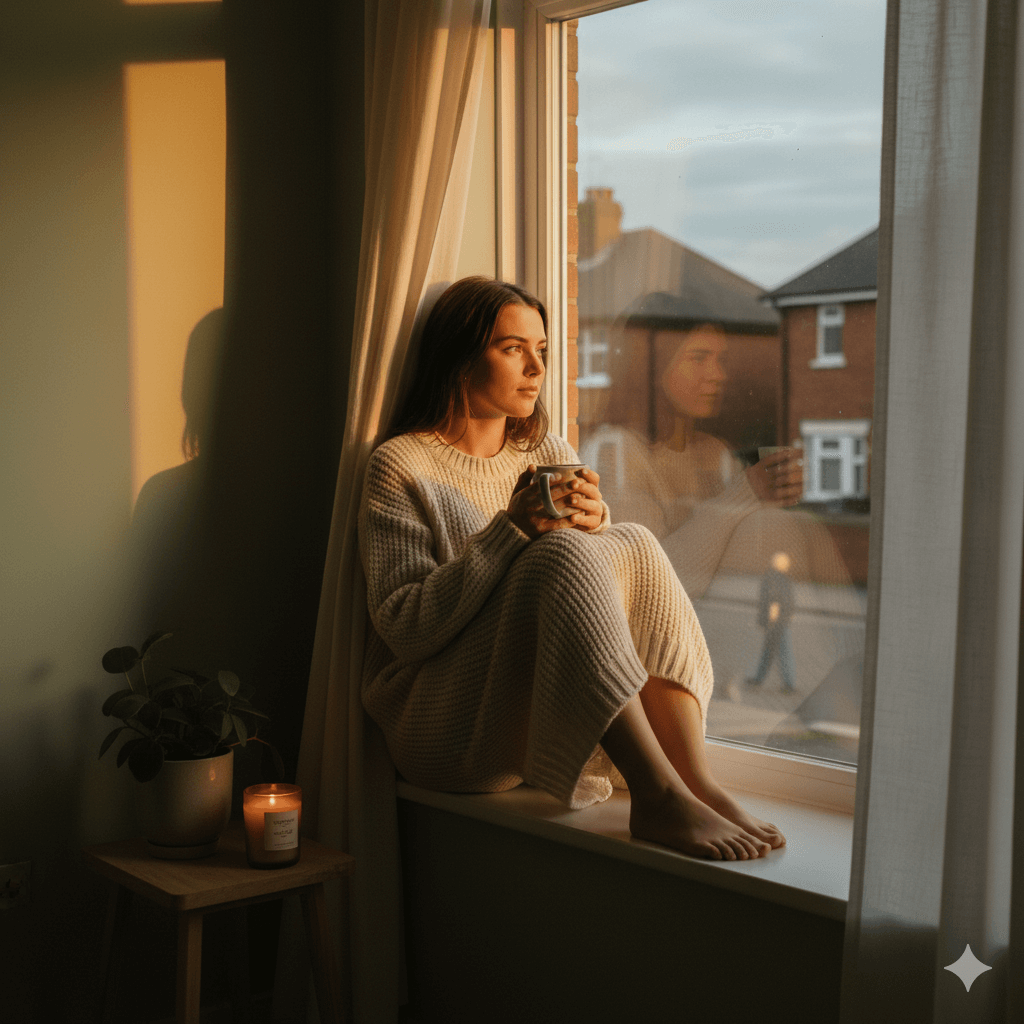Read time: 11 minutes
Quick Summary: You’re here but not really here you’re rushing through days, snapping at people you love, exhausted by mental noise. Buddhist principles offer practical tools for presence and calm – no spiritual beliefs required, but welcomed if that’s your path. Learn how to stop living on autopilot, starting with one conscious breath.
Quick Takeaways:
- Break autopilot with everyday presence anchors (no meditation required)
- Stop emotional spiraling by naming feelings without feeding them
- Use breath as a reset button in overwhelming moments
- Practice non-attachment to what you can’t control
- Build gratitude as daily mental hygiene

Table of Contents
- You Snapped at Someone You Love This Morning
- The Real Cost of Living on Autopilot: You're Missing Your Own Life
- Why Your Brain Defaults to Autopilot Mode
- Can You Practice Buddhist Mindfulness Without Meditation?
- How One Routine Task Can Break Your Autopilot Loop
- The Practice That Stopped Me From Missing My Own Life
- How Buddhist Non-Attachment Saved Me From Road Rage (And Made Me Proud of My Husband)
- How to Acknowledge Emotions Without Being Hijacked by Them
- What's the Easiest Buddhist Practice for People Who Don't Meditate?
- Stop living on autopilot : 3 Buddhist Practices You Can Start Today
- Everyday Mastery Steps You Can Take Now
- Mr Critic Moment:
You Snapped at Someone You Love This Morning
Living on autopilot has become your default setting, and it’s costing you moments you can’t get back.
It was something small. They asked a simple question while you were making coffee, and instead of answering, you snapped. Your voice had that edge, the one that makes them go quiet.
You didn’t mean to. You weren’t even angry at them. But your mind was already three hours ahead—replaying yesterday’s mistake, rehearsing today’s meeting, worrying about the thing you forgot to do.
When they spoke, it felt like an interruption to the mental chaos already consuming you.
This is what living on autopilot looks like: you’re here, but you’re not really here.
You finish washing up later and can’t remember doing it.
Your hands were in warm water, but you weren’t there, you were planning dinner while doing lunch dishes, thinking about tomorrow while missing today.
You drive to work and realize you don’t remember the journey. Not a single traffic light. Not one turn.
Your body did it all on autopilot while your mind was somewhere else entirely.
Someone asks you a question at your desk and you have to say “sorry, what?” because even though you were looking at them, nodding, appearing present you weren’t actually listening.
You were mentally already in the next meeting, the next task, the next problem.
By evening, you collapse on the couch. Exhausted.
Not from what you did, but from the constant background noise in your head. The rushing. The mental rehearsals. The feeling that you’re always behind, always reacting, never quite catching up.
When was the last time you were fully present for an entire hour?
And It Gets Worse When You Try to Wind Down
You scroll your phone before bed, telling yourself you’re relaxing.
But thirty minutes disappear and you feel more drained, not less. Your eyes are tired but your mind is wired.
When you finally close your eyes, that’s when it really starts.
The regrets replay. Why did I say that? Why didn’t I do this differently?
The worries multiply. What if tomorrow goes wrong? What if I can’t handle it?
You lie there, body exhausted, mind racing, caught between the past you can’t change and the future you can’t control. Sleep feels impossible. Presence feels like a luxury you can’t afford.
This compounds when things go wrong during the day.
Someone cuts you off in traffic and rage floods your body instantly.
Your inbox explodes and anxiety grips your chest before you’ve even read the first message.
A colleague makes a comment and you’re still replaying it hours later, building stories about what they meant, what you should’ve said back.
You’re not choosing these reactions. They’re hijacking you on autopilot responses you’ve repeated so many times they’ve become automatic.
And by the time you notice, you’re already swept up in them heart racing, jaw clenched, thoughts spiralling.
Has a small frustration ever ruined your entire afternoon?

The Real Cost of Living on Autopilot: You’re Missing Your Own Life
Here’s what nobody tells you about living on autopilot:
You’re not just tired and not just stressed.
You’re here, but you’re not really here.
The small moments that used to feel good the morning coffee, a walk outside, a conversation with someone you care about, they pass by unnoticed.
You’re physically present but mentally gone.
Your relationships suffer because people can feel when you’re not really listening.
Work suffers because you’re doing three things badly instead of one thing well.
Mental health suffers because you’re adding layers of worry and regret to everything that happens.
And the shame creeps in too. The thought that whispers: “Everyone else seems to manage. Why can’t I just stay calm? Why can’t I be present. What’s wrong with me?”
You’ve tried to fix it.
Maybe you downloaded a meditation app, but when you sat down, your mind raced even more. You felt like you were doing it wrong. You couldn’t focus. So you stopped.
Maybe you told yourself you’d be more mindful, but that lasted a day, maybe two before life pulled you back into the rush.
You know something needs to change.
But meditation feels too slow. Mindfulness apps feel forced. Spiritual practices feel… not you.
Sound Familiar?
Why Your Brain Defaults to Autopilot Mode
There’s nothing broken here.
Mindfulness isn’t missing — just buried under noise.
Calm isn’t gone only forgotten.
It’s the world that trains the mind to run on autopilot.
Your brain is doing exactly what it’s supposed to do—scanning for threats, planning ahead, trying to keep you safe. But modern life has hijacked that ancient survival system and turned it into a source of constant mental noise.
According to a 2010 Harvard study, people spend 47% of their waking hours thinking about something other than what they’re currently doing. And when minds wander like this, people report being significantly less happy—regardless of what they’re actually doing.
“The present moment is the only time over which we have dominion.” — Thich Nhat Hanh, Buddhist teacher and peace activist
Translation: You’re mentally absent for nearly half your life. And it’s not just exhausting you—it’s making you miserable.
The notifications that pull your attention every few minutes.
The to-do list that never ends.
The social media scroll that trains you to live through other people’s moments instead of your own.
The work culture that demands multitasking, which really means doing everything poorly.
The result? You feel:
- Rushed — even when you’re not actually running late
- Reactive — snapping at people, spiraling into worry, losing your calm over small things
- Disconnected — from yourself, from others, from moments that should feel meaningful
- Exhausted — not from doing too much, but from never mentally resting
- Inadequate — like you should be better at this, but you just… can’t
You’ve wondered: “Can Buddhism actually help with anxiety and stress? Or is staying calm just for people who are naturally that way? Is it even realistic for regular people like me?”
Here’s the truth: there is an alternative. And it doesn’t require hours of meditation or spiritual commitment.
By the end of this post, you’ll have the tools to help you stop living on autopilot including:
- 3 practical Buddhist tools you can use today (no cushion, no chanting, no apps)
- Real stories of how these practices stopped emotional hijacking in real-world moments (like a car crash)
- Science-backed proof these techniques actually rewire your brain for calm
- Journaling prompts to help you identify where autopilot is stealing your life
- Actionable steps to break the autopilot cycle—starting with one simple morning habit
You don’t need to fix everything. You just need to start noticing.
Keep reading.
Can You Practice Buddhist Mindfulness Without Meditation?
Here’s what most people don’t know: you can engage with Buddhism on your terms.
If temple rituals work for you, if monk chanting feels transformative, if exploring rebirth and enlightenment deepens your practice—beautiful. Keep that. Lean into it. Those traditional practices have helped millions of people for thousands of years, and there’s real power in spiritual commitment.
But if that’s not where you are right now? If you’re spiritually curious but not ready to adopt beliefs? If you’re firmly secular and just want practical tools? You can still benefit from Buddhist practices.
Yes, you can practice Buddhist mindfulness without meditating.
What I’m offering here is a psychological approach to Buddhist principles—the attention-training, emotional regulation, and presence practices that work regardless of your spiritual views. This is a 2,500-year-old toolkit for living with less suffering and more presence.
That’s what modern Buddhism is about: take what fits, leave what doesn’t. Let it lead you to be your best self, in whatever form that takes for you.
Maybe chanting works or aybe it’s just three conscious breaths before your day starts. Maybe it’s noticing the warm water while you wash up.
You don’t have to become a monk and you don’t have to sit in meditation for hours. You don’t even have to call yourself Buddhist.
Whether you approach this as spiritual practice or psychological technique, these tools work. Your path is valid.
And here’s the honest truth: staying mindful isn’t about being calm 24/7. It’s not about never getting anxious or angry. It’s about noticing when you’re on autopilot and choosing to come back. Again and again. Imperfectly.
The best part? Modern neuroscience is proving these practices actually work, for anxiety, stress, emotional regulation, and mental health.
You don’t need to meditate for hours or sit cross-legged or chant anything. You just need three core Buddhist practices that fit into the life you already have:
Buddhist non-attachment means:
- Letting go of outcomes you can’t control
- While still taking action on what you can
- Without adding extra suffering through worry or regret
The 3-Step Presence Reset:
- Notice you’re on autopilot
- Take three conscious breaths
- Name one thing you’re grateful for
These aren’t abstract concepts. They’re practical skills you can build—one conscious moment at a time.
Let me show you how.

How One Routine Task Can Break Your Autopilot Loop
You probably have a task you despise it might be washing dishes, or folding the laundry again!, maybe it’s your commute.
For me, it was the dishes.
I’d stand at the sink, hands in soapy water, but mentally I was somewhere else. Worrying about tomorrow’s meeting. Replaying an awkward conversation. Planning dinner while doing lunch dishes. And arguing in my head why im the only adult seemingly capable of doing this dam chore.
Sound familiar? That complete mental absence while your body goes through the motions?
Here’s what changed everything: I stopped resisting it.
Instead of rushing through to get back to “real” tasks, I felt the warm water on my hands—really felt it. Noticed the temperature. The texture of the soap bubbles. I looked out into the garden. Saw the birds at the feeder. The way light moved through the trees.
And something shifted.
Not because the task became profound. But because I was actually there. Present. Not thinking about washing up just doing it.
That’s the first Buddhist principle in action: presence.
It’s not about making every moment special. It’s about being awake to the moments you’re already in and breaking autopilot by anchoring your attention to what’s actually happening.
Now? Washing up is one of my favourite parts of the day. It’s become this quiet reset between tasks, a few minutes where I’m not anywhere else. Just here. Hands in water. Eyes on the garden. Mind… calm.
This dishwashing mindfulness practice for beginners requires no special setup—just warm water, attention, and willingness to notice three simple things.
Your turn what’s your task? The one you always rush through on autopilot? What if you slowed down just once this week and actually noticed it?
Try this now: Next time you do that task, notice three things – one sensation you feel, one sound you hear, and one thing you can see. That’s it. Just three things. Nothing else needs to happen.
You’ll forget. Your mind will wander to your to-do list within seconds. That’s not failure, that’s completely normal. Just notice you’ve drifted, and gently bring your attention back. That gentle return? That’s the entire practice.
The Practice That Stopped Me From Missing My Own Life
I used to walk through life like I was somewhere else.
Rushing from A to B. Planning the next thing. Worrying about something that hadn’t happened yet. Completely ignoring my surroundings—the sounds, the smells, the wind, the feel of the ground under my feet.
I wasn’t just distracted. I was absent. Operating completely on autopilot.
Then I started a simple practice: noticing where I walk.
Not mindfulness walking with special techniques. Just… paying attention.
I notice the texture of the pavement. The sound my footsteps make. The temperature of the air. The way light hits buildings. The smell of rain coming, or coffee from a café, or cut grass.
And here’s what I discovered: life is happening around me all the time. I was just never paying attention.
This is what Buddhism calls “beginner’s mind”—seeing things as if for the first time, even when they’re ordinary. It’s the opposite of autopilot.
“The little things? The little moments? They aren’t little.” — Jon Kabat-Zinn, founder of Mindfulness-Based Stress Reduction
Try this right now: Pick any object near you. A flower, a leaf, your coffee cup. Look at it—really look—for one full minute. Notice colors, textures, shadows. Your mind will want to wander. That’s fine. Just bring it back.
That’s the practice. Not achieving anything. Not “meditating.” Just training your brain to be present instead of racing ahead or dwelling behind.
It sounds small. But when you start noticing where you actually are, everything feels different. Less rushed. More real.
Pause and reflect: What’s one small thing around you right now that you usually overlook? Write it down, even just in your phone’s notes. What did you notice about it when you really looked?

How Buddhist Non-Attachment Saved Me From Road Rage (And Made Me Proud of My Husband)
We had a minor car accident recently.
A guy literally slammed into us on a roundabout. No warning. No reason. Just one of those things that happens when someone stops paying attention.
My husband’s immediate reaction? Shouting. Swearing. Shaking with adrenaline and anger, exactly what you’d expect when someone crashes into you for no good reason.
I took a breath and said: “We’re safe. It’s just a car. And that old guy who just hit us is probably mortified.”
Pause.
My husband got out. Asked the guy if he was okay. Then offered to take him home.
I was so proud.
Because here’s what happened:
We practiced Buddhist non-attachment in a real-life car crash situation—not as theory, but as an immediate response to chaos. Even in crisis, autopilot reactions can hijack your response unless you’ve trained yourself differently.
Not non-attachment meaning “don’t care.” But non-attachment meaning: “This already happened. I can’t undo it. So what’s the point in adding rage to a situation that’s already done?”
The car was damaged. The insurance would be a hassle. We’d lose time dealing with repairs.
But shouting wouldn’t fix the car. Anger wouldn’t undo the crash. The guy had already hit us, nothing we could control from that point.
This is where Buddhism and Stoicism overlap perfectly: focus on what you can control. Let go of what you can’t.
We still felt frustrated. But we didn’t spiral into it. We didn’t let the emotion hijack the rest of our day.
That’s the difference between reacting and responding. And it’s a skill you build just one conscious breath at a time.
Your turn: Think about something that went wrong recently, something small, not traumatic. Write it down. Then answer: What part could you control? What part couldn’t you? Where did you add extra suffering by dwelling on what you couldn’t change?
You don’t need to do this perfectly. You’re not trying to never feel frustrated. You’re just practicing noticing the difference between the situation and your reaction to it.
How Long Does It Take to Stop Living on Autopilot With Buddhist Techniques?
You’ll notice shifts immediately—the first time you catch yourself on autopilot, that’s already progress. But rewiring your default patterns takes consistency.
A 2011 Harvard study found that just eight weeks of mindfulness practice (which is basically Buddhist attention training) increased gray matter density in brain regions linked to memory, empathy, and stress regulation.
Translation: when you practice being present—even in small ways like noticing your breath or really looking at something—you’re literally strengthening the parts of your brain that help you stay calm and connected.
Another study in Psychological Science showed that people who practiced non-attachment (letting feelings come and go without clinging) experienced less anxiety and recovered faster from stress.
Dr. Rick Hanson, a neuropsychologist who studies contemplative practices, puts it simply: “The brain takes its shape from what the mind rests upon.”
So if your mind constantly rests on worry, frustration, and rushing—that’s the pattern it strengthens. But if you practice resting on breath, presence, and gratitude? That becomes your new default.
Brain structure changes appear after 8 weeks of regular practice—even just 3-5 minutes daily.
You’re not trying to become enlightened. You’re just retraining your nervous system to default to calm instead of chaos. Each time you notice and return, you’re weakening autopilot’s grip.
And that happens one conscious moment at a time.
How to Acknowledge Emotions Without Being Hijacked by Them
Old wounds still appear for me. Difficult emotions still show up. I’m not a master at this, sometimes they linger longer than necessary, and I hold onto them when I probably shouldn’t.
But I’m learning to acknowledge emotions without being hijacked by them.
When anxiety hits, I notice: “This is anxiety.”
When frustration rises: “This is frustration.”
I don’t push it away and Idon’t tell myself I shouldn’t feel it. I just… let it be there. Feel where it sits in my body. Watch it without adding more thoughts about why I’m feeling it or what it means about me.
And usually, not always, but usually it will pass quicker than when I resist it or build stories around it.
This is Buddhist emotional intelligence: emotions are like weather. They arise, peak, and pass. You don’t have to be swept away by every storm.
The practice isn’t suppressing emotion. It’s noticing the difference between feeling something and becoming it.
You feel angry and you don’t have to be an angry person.
You feel anxious but you don’t have to become your anxiety.
There’s space between the emotion and your response. Buddhism teaches you how to find that space—and use it.
“You can’t stop the waves, but you can learn to surf.” — Jon Kabat-Zinn
Can Buddhist mindfulness help with anxiety without being spiritual?
Yes, because you’re training your nervous system to observe feelings without amplifying them. These practices interrupt autopilot patterns by training attention. It’s not about faith. It’s about attention.
This isn’t about fixing yourself. You’re not broken. It’s about learning to be with yourself—all of it—without adding extra suffering on top.
Experiment this week: Next time a difficult emotion shows up—frustration, sadness, anxiety—try this: Don’t fix it. Don’t analyze it. Just name it (“This is frustration”) and notice where you feel it in your body. Tight chest? Clenched jaw? Hot face?
Stay with that physical sensation for 30 seconds. Just observe. You’ll probably want to distract yourself or push it away. That’s normal. See if you can stay just a little longer.
Then write one sentence: “When I felt [emotion], I noticed it in my [body part]. After 30 seconds, it [stayed the same/got stronger/started to ease].”
You’re not trying to make it go away. You’re just learning that you can be with it without being consumed by it.
What’s the Easiest Buddhist Practice for People Who Don’t Meditate?
Let’s be clear: I don’t meditate. Not in the traditional sense.
I don’t sit in lotus position. I don’t use apps with soothing voices telling me to “observe my thoughts.” I don’t have a 20-minute practice.
What I do have is the breath reset button for anxiety a daily breathing practice that requires no special setup.
Every morning, I take 3-5 minutes—sometimes sitting, sometimes standing, sometimes still in bed, and just breathe. Slowly. Deliberately. Noticing the inhale. The exhale. The pause in between.
That’s it.
No visualization or mantras. No goal beyond being present with my breath for a few moments before the day rushes in.
The 3-breath reset technique: Before your feet hit the floor, before you reach for your device, before anything – just breathe. Slowly. Three times. Then name one thing you’re grateful for.
And then I practice gratitude. Not in a “manifestation” way. Just acknowledging what’s already here.
Grateful for the wind, for my family. Grateful for this morning and for warm water and the view from my kitchen window.
It sounds small. It is small.
But it’s changed the way I live.
Because gratitude shifts your attention from what’s missing to what’s here. From what’s wrong to what’s working. It’s not toxic positivity, it’s just choosing to notice what you’d normally overlook on autopilot.
And breathing? That’s your anchor. The one thing that’s always here, always available, always yours.
When life gets overwhelming, you don’t need an hour of meditation. You just need three conscious breaths.
That’s Buddhism. That’s the practice.

Stop living on autopilot : 3 Buddhist Practices You Can Start Today
You don’t need a teacher, special training, or any setup. Just these:
1. Turn one routine task into your presence anchor.
Pick something you do every day washing dishes, making tea, brushing your teeth, walking to your car. For the next week, do it slowly. Notice every sensation. The temperature. The texture. The sounds. Let your mind wander, then gently bring it back. That’s the practice. That’s how you break autopilot.
2. Acknowledge one feeling without feeding it.
Next time frustration, anxiety, or sadness shows up, pause. Name it: “This is frustration.” Feel where it sits in your body. Don’t push it away. Don’t build a story around it. Just watch it like weather passing through. This is how you stop being hijacked by emotion and break the autopilot response cycle.
3. Take three breaths before checking your phone.
Before your feet hit the floor, before you reach for your device, before anything – just breathe. Slowly. Three times. Then name one thing you’re grateful for. Even if it’s just “I slept” or “the heating works.” This resets your brain toward noticing what’s here instead of what’s missing.
Everyday Mastery Steps You Can Take Now
Link presence to something you already do. Morning tea. Evening walk. The commute. Pick one existing habit and turn it into your anchor for waking up to your life. This is how small practices become automatic, you’re stacking awareness onto routines that already exist. Learn how to build habits that actually stick here.
Use breath as your reset button. When life gets overwhelming, don’t search for calm, just take three slow breaths. In through the nose. Out through the mouth. That’s your practice. That’s enough. Breath is always with you—it’s the one anchor you can access anywhere, anytime, even in the middle of autopilot moments.
Practice the “car crash test.” Next time something goes wrong, pause before reacting. Ask: “Can I change this? No? Then what’s the point in adding more suffering?” Not to suppress your feelings- just to notice when you’re making things worse. This is non-attachment in real time. Discover how to spend your life tokens wisely instead of wasting them on what you can’t control.
Mr Critic Moment:

Mr Critic Moment:
“So you’re saying if I just breathe and notice things, I’ll magically stop feeling stressed? What if I can’t focus? What if my mind just races?”
No. Buddhism won’t fix everything. You’ll still have hard days. Still get frustrated. Still hold onto things longer than you should.
Your mind will wander during breath work—that’s normal. That’s not failure. The practice isn’t staying focused. It’s noticing when you’ve drifted and gently coming back. That’s it. That’s the whole thing.
And here’s what changes: you’ll notice when you’re doing it. And noticing is the first step to choosing differently.
Mr Critic wants you to need perfection before you start. Buddhism just asks you to start. Messy, imperfect, one conscious breath at a time.
You’re not incapable of being mindful. You’re just learning. And learning means getting it “wrong” most of the time until slowly, gradually, autopilot’s grip loosens and it starts to stick.
Try whispering back: “Maybe noticing is enough. Maybe I don’t have to master this to benefit from it. Maybe growing within myself doesn’t require being perfect.”
Recognize Your Autopilot Patterns: Frequently Asked Questions About Buddhist Mindfulness Without Meditation
Can Buddhist mindfulness help with anxiety without being spiritual?
A: Yes. Buddhist techniques like breath awareness and non-attachment work for anxiety because they’re psychological tools, not religious practices. You’re training your nervous system to observe feelings without amplifying them—no spirituality required. Research shows these practices reduce anxiety by helping you notice the gap between feeling anxious and becoming consumed by anxiety. They interrupt autopilot reactions that amplify stress.
What’s the easiest Buddhist practice for beginners who don’t meditate?
A: Start with “presence anchors”—turn one routine task you already do (washing dishes, making tea, walking) into a moment of full attention. Notice three things: one sensation, one sound, one sight. That’s it. No sitting. No apps, and no special time commitment. Just noticing where you actually are for a few moments each day. This simple practice begins to weaken autopilot’s hold.
How long does it take to stop living on autopilot with Buddhist techniques?
A: You’ll notice shifts immediately – catching yourself on autopilot is already the practice. But rewiring your default patterns takes consistency. Harvard research shows brain structure changes appear after 8 weeks of regular practice, even just 3-5 minutes daily. You’re not trying to become enlightened, you’re just retraining your nervous system to default to calm instead of chaos. Each conscious return weakens the autopilot pattern.
Do I need to believe in Buddhism to use these practices?
A: Not at all. These are attention-training techniques backed by neuroscience. Take what works, leave what doesn’t. You’re not becoming Buddhist—you’re just learning to be present in your own life. Think of it like using yoga for flexibility without adopting Hindu beliefs. The practices work regardless of your spiritual views and help you notice when you’re on autopilot.
What if my mind races and I can’t stay focused during breathing exercises?
A: That’s completely normal and not a sign of failure. Your mind wandering isn’t the problem—it’s the practice. The entire point is noticing when you’ve drifted and gently bringing your attention back. That gentle return, repeated over and over, is what rewires your brain. You’re not trying to stop thoughts. You’re just practicing the skill of noticing and returning. Even that is breaking the autopilot loop.

Journaling Prompts:
When today was I on autopilot instead of actually present?
What emotion have I been holding onto that I could acknowledge and let pass?
What would change if I spent less time worrying about things I can’t control?
The small thing can I feel grateful for right now, in this exact moment?
That’s it. A few sentences. A bit of noticing. That’s the practice.
What Comes Next
Buddhism won’t make your life perfect. But it will help you stop missing it.
You’ll still have stressful days, difficult emotions, things that go wrong. The difference is you won’t add extra suffering by being mentally absent, emotionally reactive, or clinging to outcomes you can’t control.
You’ll just be more… here. Present. Awake. Less on autopilot, more in your actual life.
And that’s not a small thing. That’s everything.
Your next steps:
- Try just one practice from this post this week. Not all three. Just one. See what happens.
- Notice when you fall back into autopilot (you will)—that noticing IS the practice.
- If you found this helpful, join the Everyday Mastery newsletter for weekly insights on building presence, calm, and self-belief—one small practice at a time.
Want to see how Buddhist presence combines with Stoic discipline? Read The Stoic Reflection Habit Loop—it’s the perfect companion practice for building daily awareness.
And if you’re struggling with where your time and attention actually go, How to Spend Your Life Tokens will help you see what’s worth being present for.
I’d love to hear from you: What’s one small moment this week where you caught yourself being present instead of on autopilot? Drop a comment or share it in the newsletter—your small win might inspire someone else to start noticing too.

Bottom Line – YOu can Stop living on autopilot
You’re not broken. You’re just living on autopilot—rushing, reacting, disconnected from your own life.
Buddhist principles offer a way out. Not through mandatory spirituality or hours of meditation. Just through small, practical tools:
- Notice where you are instead of sleepwalking through it
- Let emotions pass instead of being hijacked by them
- Focus on what you can control instead of spiraling over what you can’t
- Choose gratitude for what’s here instead of fixating on what’s missing
Small practices. Real change. One conscious moment at a time.
That’s not Buddhism as religion. That’s just everyday mastery.
Remember that person you snapped at this morning?
Tomorrow morning, before the rush starts, take three breaths. Notice you’re here. Then choose how you want to show up.
That’s the practice. That’s where it begins.
Try it for one day. See what changes when you stop living on autopilot.
What’s one moment this week where you caught yourself on autopilot?
Drop one word below—the feeling you want more of: “Present” – “Calm” – “Awake”
Disclaimer: I’m a coach, not a clinician. What I share comes from real practice and personal growth, not therapy. If you’re finding things hard, it’s okay to get professional support—it makes a difference.
Enjoy reflections like this? you can join the Everyday Mastery newsletter here—calm, practical insights sent straight to your inbox once a week.
If you enjoy these posts and want to support the writing, you can buy me a coffee—it keeps the kettle (and the ideas) warm.
Kel is the writer behind Everyday Mastery, where she shares the real, messy, and meaningful process of building habits, resilience, and self-belief from the ground up. Her writing blends ancient philosophy with modern science, always focused on small, practical steps that lead to lasting





